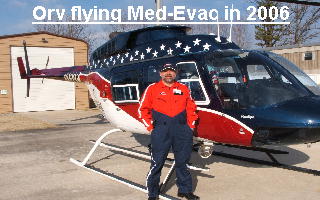 |
|
HINTS AND TIPS The Buttons below will take you through the different hints and tips that I feel will make your helicopter safer and more reliable. |
A.R.O.W. is an acronym that stands for the items that must be in the aircraft for it to be legal to fly and considered “AIRWORTHY” by the FAA regulations. The Airworthiness certificate and the registration should be inside of a plastic see-through document envelope (available from suppliers like Aircraft Spruce and Specialty( link)) and needs to be securely attached to the inside of the cockpit in plain view for any passenger to see. On the Rotorway the document display is usually installed on the passenger (right) side of the cockpit and either on the bottom door post near the foot well or under the instrument panel bulge next to the passengers left ankle.
- a. Airworthiness Certificate- issued by FAA
- b. Registration- issued by FAA and N numbers of appropriate size and color mounted on side of aircraft
- c. Operators Handbook- came with the kit/operating limitations-issued at time of FAA inspection
- d. Weight and balance calculations- completed by builder. These include calculations for the present weight of the student. The instructor, Orv weighs in at around 185 pounds for your calculations. (once we schedule your flight training I will send you a very easy weight and balance computing program).
Current Medical:
- a. Student pilot certificate or third class medical current (student pilot certificate is issued by your medical examiner).
- b. You need to check your operators hand book to determine the maximum pilot and passenger weights that are allowed in your particular helicopter. If you are over that weight, it would be a good incentive to loose some of that extra poundage that you have been carrying around. It takes around one horse power for the helicopter to lift every 7 pounds.
Birth Certificate or Passport
- a. Need for homeland security requirement to receive flight instruction
- b. Please have an original or certified copy for me to view and a copy to take with me for my records.
Students Age
- a. Aids me in determining how long to schedule training for
- b. Older students typically get tired easier than the young students so our flying sessions are typically a bit shorter
Intercom
- a. Installed and operating.
- b. If you have not yet purchased an intercom I have found the ones that are self contained seem to work the best in the helicopter environment
Headset Jacks
- a. For two headsets
- b. Airplane or Helicopter configuration(helo has one jack for each headset, airplane has two for each headset)
Radio/transponder/encoder (that are certified) If during your training we will be flying into the mode C veil of a class Bravo air space or inside of a class Charlie air space, the helicopter must have a properly functioning transponder with altitude encoder that has been certified within the past 24 calendar months from the time of our flight. .
- a. Certified (certification is good for 24 months) It must be installed in the aircraft and then certified by an FAA licensed avionics technician while in the helicopter. The helicopter can be taken by trailer or flown to the repair station or the avionics technician may be talked into coming to your hangar.
Annual Current
- a. Does the builder have a repairman’s certificate (then he can perform and sign annual condition inspection in aircraft log book). This is issued by the FAA at the time of your airworthiness inspection if it is performed by and FAA inspector. If your helicopters airworthiness inspection was performed by a DAR (Designated Airworthiness Representative) then you will need to contact your local FSDO(Flight Standards District Office) to have it issued to you.
- b. If not then an A&P must have signed that the helicopter has had it's annual condition inspection within the past 12 months to include the month that we are to be training if your helicopter is an Experimental. If we will be flying a Certified helicopter then the annual condition inspection must be signed off by an IA (this is an A&P mechanic with Inspection Authorization).
| DISCLAIMER: The material on each page is the opinion of the author only and any actions taken by the reader relating to information on this site is the responsibility of the builder. |